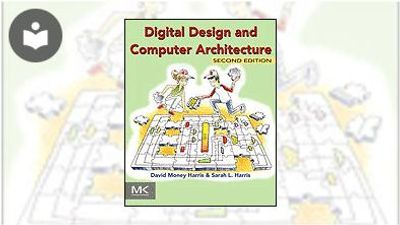Digital Design and Computer Architecture, Second Edition
- 11h 42m
- David Money Harris, Sarah L. Harris
- Elsevier Science and Technology Books, Inc.
- 2013
Digital Design and Computer Architecture takes a unique and modern approach to digital design. Beginning with digital logic gates and progressing to the design of combinational and sequential circuits, Harris and Harris use these fundamental building blocks as the basis for what follows: the design of an actual MIPS processor. SystemVerilog and VHDL are integrated throughout the text in examples illustrating the methods and techniques for CAD-based circuit design. By the end of this book, readers will be able to build their own microprocessor and will have a top-to-bottom understanding of how it works. Harris and Harris have combined an engaging and humorous writing style with an updated and hands-on approach to digital design.
This second edition has been updated with new content on I/O systems in the context of general purpose processors found in a PC as well as microcontrollers found almost everywhere. The new edition provides practical examples of how to interface with peripherals using RS232, SPI, motor control, interrupts, wireless, and analog-to-digital conversion. High-level descriptions of I/O interfaces found in PCs include USB, SDRAM, WiFi, PCI Express, and others. In addition to expanded and updated material throughout, SystemVerilog is now featured in the programming and code examples (replacing Verilog), alongside VHDL. This new edition also provides additional exercises and a new appendix on C programming to strengthen the connection between programming and processor architecture.
SECOND Edition Features
- Covers the fundamentals of digital logic design and reinforces logic concepts through the design of a MIPS microprocessor.
- Features side-by-side examples of the two most prominent Hardware Description Languages (HDLs)-SystemVerilog and VHDL-which illustrate and compare the ways each can be used in the design of digital systems.
- Includes examples throughout the text that enhance the reader's understanding and retention of key concepts and techniques.
Updated based on instructor feedback with more exercises and new examples of parallel and advanced architectures, practical I/O applications, embedded systems, and heterogeneous computing
- Presents digital system design examples in both VHDL and SystemVerilog (updated for the second edition from Verilog), shown side-by-side to compare and contrast their strengths
- Includes a new chapter on C programming to provide necessary prerequisites and strengthen the connection between programming and processor architecture
About the Authors
David Money Harris is a professor of engineering at Harvey Mudd College. He received his Ph.D. in electrical engineering from Stanford University and his M.Eng. in electrical engineering and computer science from MIT. Before attending Stanford, he worked at Intel as a logic and circuit designer on the Itanium and Pentium II processors. Since then, he has consulted at SunMicrosystems, Hewlett-Packard, Evans & Sutherland, and other design companies.
David holds about a dozen patents and is the author of three other textbooks on chip design, as well as four guidebooks to the Southern California mountains.
Sarah L. Harris is an associate professor of engineering at Harvey Mudd College. She received her Ph.D. and M.S. in electrical engineering from Stanford University. Before attending Stanford, she received a B.S. in electrical and computer engineering from Brigham Young University. Sarah has also worked at Hewlett-Packard, the San Diego Supercomputer Center, and Nvidia.
In this Book
-
From Zero to One
-
Combinational Logic Design
-
Sequential Logic Design
-
Hardware Description Languages
-
Digital Building Blocks
-
Architecture
-
Microarchitecture—With contributions from Matthew Watkins
-
Memory and I/O Systems
-
Further Reading



